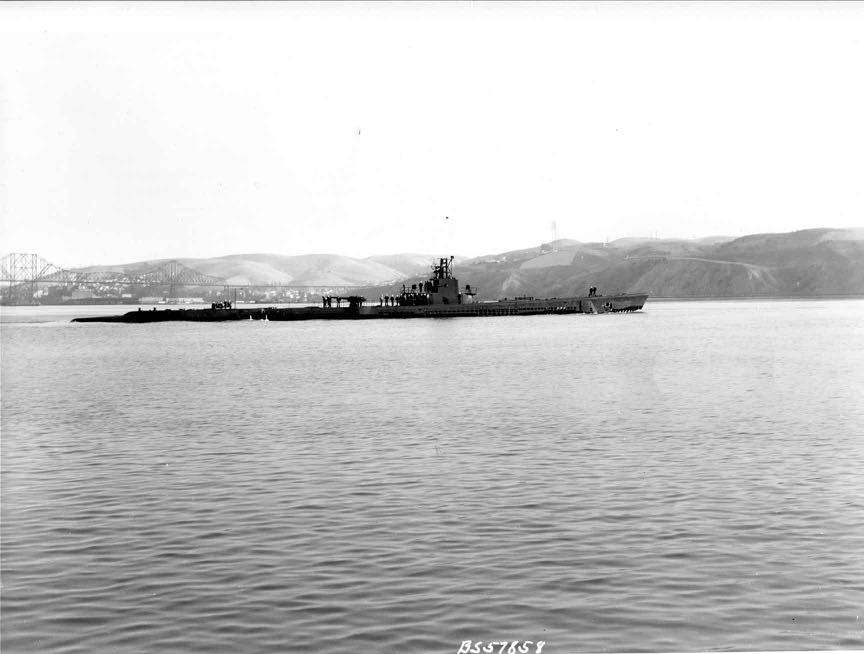Gar SS-206

Gar
Any of certain fishes having an elongate pike-Like body and long, narrow jaw.
( SS-206: dp. 1,475, 1. 307'2" b. 27'3", dr. 13'3", s. 20 k. (surf.), 8.75 k. (subm.) cpl. 59; a. 1 3", 2 .50
cal. mg., 2.30 cal. mg.; 1021" tt.; cl. Tambor)
Gar was launched 7 November 1940 by the Electric Boat Co., Groton, Conn.; sponsored by Mrs. George T. Pettingill, wife of Rear Admiral Pettingill; commissioned at New London 14 April 1941, Lt. D. MeGregor in command.
After shakedown training along the New England seaboard from Portsmouth, N.Il., and New London, Conn., car departed New London 24 November and transited the Panama Canal 3 December 1941 enroute to San Diego, where she arrived 3 days after the Pearl Harbor attack. She prepared for combat in the Mare Island Naval Shipyard then departed San Francisco 15 January 1942 for Pearl Harbor. Her maiden patrol (2 February-28 March) was conducted around Nagoya and the Rii Channel entrance to the Inland Sea of Japan. She torpedoed and sank the 1,520 two cargo ship Chichibu 13 March. During her second war patrol (19 April-8 June), she scored hits on a freighter off Kwajalein atoll and a submarine decoy " Qship" west of Truk atoll, then terminated her patrol at Fremantle, Australia. Her third war patrol (3 July-21 August) took her to the South China Sea and the Gulf of Siam, where her only contact was a hospital ship. Her fourth war patrol (17 September 7 November) took her to the northernmost waters in the Gulf of Siam, where on 19 October she laid 32 mines in the entrances to Bangkok. This was one of the strategic plants covering important Japanese shipping lanes previously patrolled by American submarines.
Gar's 95th, sixth and seventh war patrols were conducted largely in approaches to Manila, Philippine Islands, via Borneo. During her fifth (28 November-19 January 1943) she drove freighter Heinan Maru on the beach with siX torpedo hits and scored hits on a seaplane tender. Her sixth (9 February-2 April) brought numerous contacts with targets which could not be closed to firing range because of vigilant enemy aircraft and antisubmarine patrol ships. During her seventh war patrol (23 April-27 May 1943), she sank five small craft with gunfire; torpedoed and sank 703-ton Japanese freighter Aso Maru south of the Negros Islands 9 May, then 6 days later attacked a convoy west of Mindoro, sinking 3,197-ton passenger-cargo ship Meikai .Maru and 4,361-ton Indus Maru.
Her eighth war patrol (18 June 23 July) was spent patrolling the Flores Sea, where she torpedoed a 500-ton motorship which ran itself aground, the crew escaping into the jungle. En route from Fremantle to Pearl Harbor on her ninth war patrol (8 August-13 September), Gar scouted off Timor and scored hits on a freighter in Makassar Strait. Routed onward for overhaul in the Mare Island Navy Yard, she returned to Pearl Harbor 30 November 1943 to resume combat patrols in the Pacific.
The 10th war patrol of Gar (16 December 1943-9 February 1944) was conducted off Palau, where on 20 January she sank the 5,325~ton cargo ship Rovu Maru; damaged two ships of another convoy on the 22d, then attacked a third convoy the following day to sink the 3,670-ton Taian Muru`, her 11th war patrol (3 March-21 April) found her performing lifeguard duty for aviators making the first carrier-based air strikes on Palau. She saved eight aviators, one less than 2 miles off the beach and within range of enemy gun emplacements. Her 12th war patrol (20 May-5 July) was spent in the Bonin Islands area, where she made gunfire attacks on a convoy of Japanese sea trucks, leaving a small freighter raging in flames and dead in the water. Her 13th war patrol (14 Augusts October) was largely taken up with lifeguard duty off Yap supporting the combined fleet-shore operations that captured the Palaus. She also performed valuable reconnaissance work off Surigao Strait. She bombarded installations on Yap 6 through 8 September and ended her patrol at Brisbane, Australia.
On her 14th war patrol (3-30 November), Gar landed 16 men and 25 tons of supplies at Santiago Cove, Luzon, Philippine Islands, 23 November; picked up intelligence documents, and terminated her patrol in Mios Woendi lagoon. On her 15th and final war patrol (4-27 December ), she landed 35 tons of supplies on the west coast of Luzon, near Duriagaos Inlet 11 December, returning to Pearl Harbor with urgent intelligence documents including maps locating enemy gun emplacements, beach defenses, troop concentrations, and fuel and ammunition dumps on Luzon.
After overhaul in the Pearl Harbor Naval Shipyard, Gar put to sea 2 April 1945 to serve the remainder of the war as a target trainer for antisubmarine ships at Saipan and Guam, Marianas Islands. She departed Apra Harbor, Guam, 7 August 1945, proceeding via Hawaii, San Francisco, and the Panama Canal to Portsmouth, N.H., where she arrived 20 October. She decommissioned there 11 December 1945 and remained in reserve until September-October 1948 during which time she was overhauled in the Portsmouth Naval Shipyard for service as a reserve training submarine for the 4th Naval District at Cleveland, Ohio, arriving, via the Mississippi River and the Chicago Canal, 28 November 1948. She continued her reserve training until her name was stricken from the Navy List 29 May 1949. The submarine was sold for scrapping 18 November 1949 to Acme Scrap Iron and Metal Go.
Gar received 11 battle stars for service in World War II.
